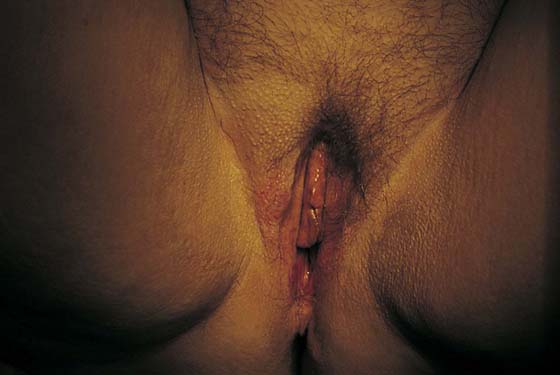Wide Excision With or Without Skin Graft
The treatment for vulvar intraepithelial neoplasia (VIN) varies depending on the extent of the disease process. Wide, local excision accomplishes therapeutic goals most simply and with the least disruption for the patient when the VIN is localized. On the basis of microscopic analysis of more than 1000 histologic sections of vulvar carcinoma in situ (CIS), the following data were obtained: (1) skin appendages (e.g., sebaceous glands, hair follicles, sweat glands) were involved (by extension) with neoplasia in 38% of all cases studied and in 60% of women older than 50 years of age; (2) skin appendages in hair-bearing areas extended to a mean depth of 1.53 ± 0.77 mm; (3) in the labia minora, extension of neoplastic cells into sebaceous glands plunged to a mean depth of 1.0 mm; and (4) the deepest skin appendage involvement (hair-bearing areas) was to a depth of 3 mm. Therefore, specifications for treatment required excision to a depth of 2.3 mm for labia majora and perineal and perianal skin; a depth of no more than 1 mm for the labia minora and periclitoral skin; and a peripheral margin of 3.0 mm (see Fig. 62–26).
Sharp excision may be performed with conventional instrument (knife, scissors) or by means of a superpulsed carbon dioxide (CO2) laser. A basic tenet for surgical treatment of the vulva is limitation of deep tissue devitalization by energy devices (e.g., electrosurgical coagulation). After the excision is done, sufficient time and effort should be expended to obtain vigorous hemostasis. Bleeding vessels should be clamped and suture-ligated with 4-0 Vicryl (Figs. 68–1 through 68–4). When the latter is completed, the operative site is irrigated with normal warm saline. Primary closure without tension on the suture is the preferred method of closure. If the skin is tightly stretched to obtain closure, the edges may undergo necrosis and separate. Alternatively, wounds that are closed under tension are vulnerable to suture tear-out when inevitable postoperative tissue edema develops.
If primary closure is impossible or is tenuous, plans should be made to graft the operative site (Figs. 68–5A through 68–12B) either with a pedicle graft or a free graft (Fig. 68–13). The principle of the pedicle graft involves preservation of a plentiful blood supply to the graft. Therefore, the surgeon must know the source and direction of the blood vessels to avoid cross-cutting them. Second, the length of the graft should be approximately one-half the width of the base (i.e., if the height of the graft is 3 cm, then the pedicle width should be 6 cm) (Figs. 68–14 through 68–20). For small areas (i.e., 2 cm wide and 4 cm long), a full-thickness graft may be excised from the lower abdomen (see Fig. 68–11). This is carefully cleared of all fat and sutured into the wound. Finally, a split-thickness graft from the thigh or buttock may be obtained preoperatively and then grafted onto the wound. In actuality, this is the preferred method of treatment for large defect coverage. For all grafts, an evenly distributed pressure dressing is applied (Fig. 68–21).
When a large, deep resection or previous iatrogenic scar formation has compromised the blood supply and created massive tissue loss in the vulva or vagina, a myocutaneous graft should be considered. This type of graft provides tissue substance, as well as a blood supply to the graft. The graft utilizes the medially located gracilis muscle (see Chapter 70), which may be delivered via a tunnel from the thigh into the perineum or vagina (Figs. 68–22 through 68–24).
FIGURE 68–1 A lesion involving the entire right labium majus.
FIGURE 68–2









